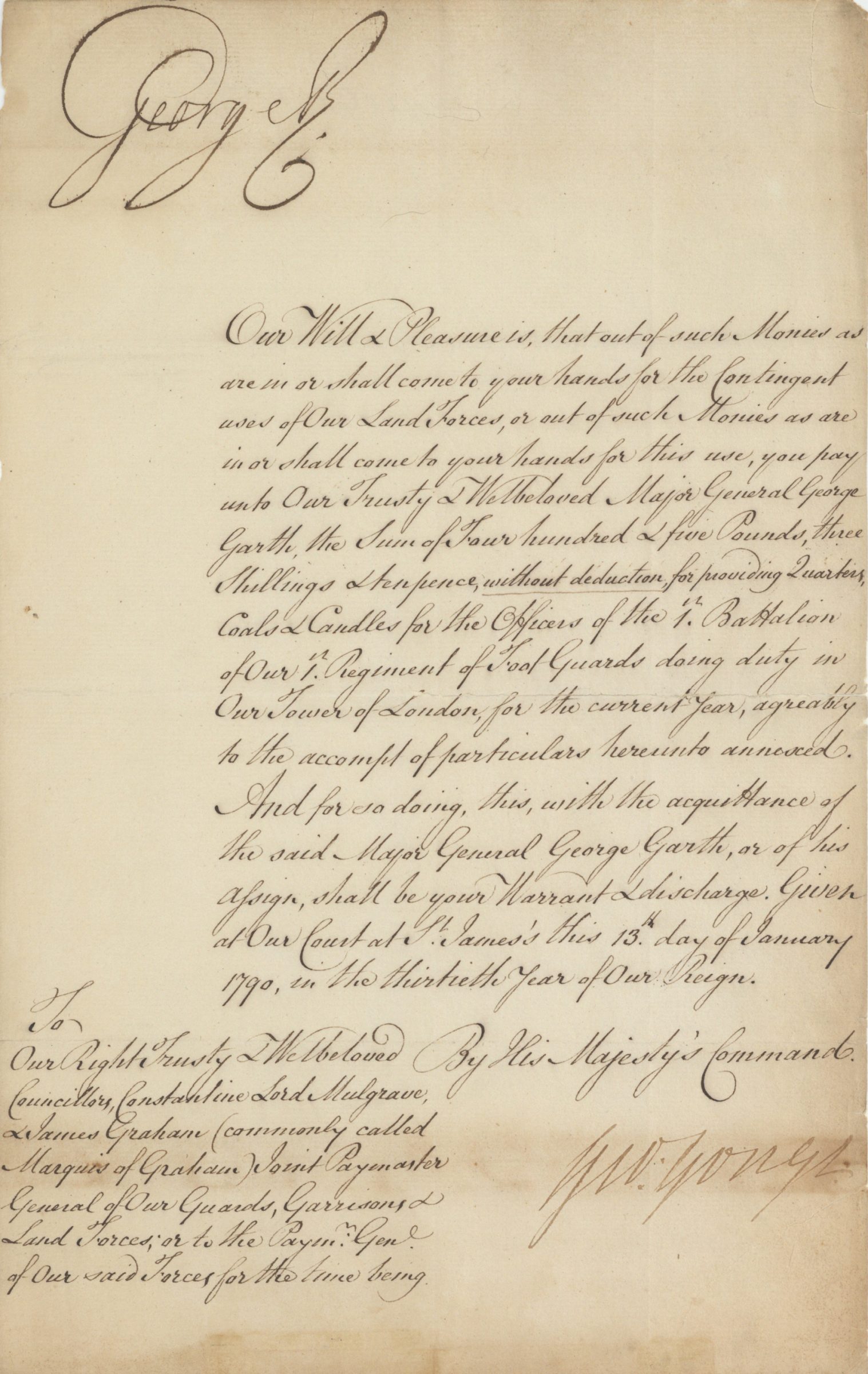King George III Orders the Payment of Expenses to Run the Tower of London


The Tower was then also the Royal Mint, and many men were stationed there to guard and operate the fortress
The King specifies the guards of the Tower need funds to operate their living quarters, coal for heat, and candles for light
Public sale records show no other similar documents relating to the Tower
When William the Conqueror built a mighty stone tower at the centre of his London fortress in the...
The King specifies the guards of the Tower need funds to operate their living quarters, coal for heat, and candles for light
Public sale records show no other similar documents relating to the Tower
When William the Conqueror built a mighty stone tower at the centre of his London fortress in the 1070s, defeated Londoners must have looked on in awe. Now nearly 1000 years later, the Tower still has the capacity to fascinate and horrify. As protector of the Crown Jewels, home of the Yeomen Warders (guarding the Tower since the time of King Henry VIII), and its legendary ravens, the Tower now attracts over three million visitors a year.
Inside, medieval kings built magnificent royal lodgings. They worshipped in the Chapel Royal, kept a menagerie of exotic animals (which lasted until the 19th century) and welcomed foreign rulers at magnificent ceremonial occasions. During the Tudor age, the Tower became the most important state prison in the country. Anyone thought to be a threat to national security came there, and many were executed, including Anne Boleyn. After, kings and queens used the Tower in times of trouble to protect their possessions and themselves. Arms and armor were made, tested and stored here until the 1800s. The Tower also controlled the supply of the nation’s money. All coins of the realm were made at the Tower Mint from the reign of Edward I until 1810. Kings and queens also locked away their valuables and jewels at the Tower and even today, the Crown Jewels are protected by a garrison of soldiers.
Document signed, the Court at St. James, London, January 13, 1790, addressed to “Our Right Trusty and Well Beloved Councillors Constantine Lord Mulgrave, James Graham (commonly called Marquis of Graham), Joint Paymaster General of Our Guards, Garrisons, & Land Forces; or to the Paymaster General of Our said Forces for the time being.” The King orders that “Our Will & Pleasure is that out of such monies…for the contingent uses of Our Land Forces…you pay unto Our Trusty and Well Beloved Major General George Garth, the sum of four hundred & five pounds, three shillings & ten pence, without deduction, for providing Quarters, Coals, & Candles for the Officers of Our 1st Battalion of Our 1st Regiment of Foot Guards doing duty in Our Tower of London for the current year…And for so doing, this…shall be your Warrant & Discharge.” King George III has signed the document at upper left, “George R.” It is countersigned by Secretary of War and Privy Councillor George Yonge.
This is the first document we have ever had relating to the Tower of London.

Frame, Display, Preserve
Each frame is custom constructed, using only proper museum archival materials. This includes:The finest frames, tailored to match the document you have chosen. These can period style, antiqued, gilded, wood, etc. Fabric mats, including silk and satin, as well as museum mat board with hand painted bevels. Attachment of the document to the matting to ensure its protection. This "hinging" is done according to archival standards. Protective "glass," or Tru Vue Optium Acrylic glazing, which is shatter resistant, 99% UV protective, and anti-reflective. You benefit from our decades of experience in designing and creating beautiful, compelling, and protective framed historical documents.
Learn more about our Framing Services










































































































